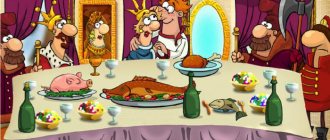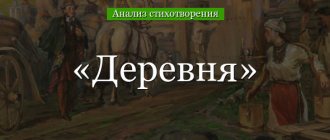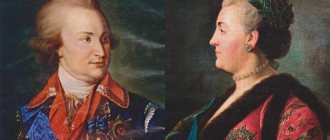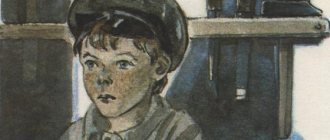Download review:
In the work, the author tells the story of one family. Pushkin's expressive poetic language creates vivid images and a fairy-tale world into which the reader plunges headlong. It is this fairy tale that is considered the pinnacle of Pushkin’s fairy-tale creativity.
“This is the most universal art, because it is equally appealing to a six-year-old child and a sixty-year-old most cultured poetry reader. No understanding is required, it is perceived directly, undeniably, directly,” literary critic D.P. Mirsky said about the work.
Pushkin's fairy tale is truly suitable not only for children, it is relevant for all ages and can be viewed at different levels of understanding. Below is a short overview of the work that can be used for a reader's diary.
Scene
The plot of the fairy tale takes place in a magical world. The main events take place in two locations: in a fictional coastal state ruled by Tsar Saltan, and on a once deserted island, unsuitable for life, where a majestic city arises, which has become the patrimony of Prince Guidon.
The text contains a toponym - Buyan Island. This name is found in Russian folklore, where there is mention that an oak tree with four branches grows on this island. The tale also features an oak tree - this is the only thing that was on the island when the heroes arrived there.
There is a version that the prototype of Buyan Island is the real-life island of Rügen, currently owned by Germany.
The sea is also one of the settings in the work. The sea plays an important role in the story. In the text it is designated as Okiyan, consonant with the word “ocean”, but written with a capital letter, as if it were the name of a body of water.
Interesting Facts
The luminary of Russian poetry, Alexander Sergeevich Pushkin, who skillfully handled the poetic syllable and glorified the richness of the Russian language, used only one word with the letter “f” in “The Tale of Tsar Saltan” - fleet. In Pushkin's era, words with this letter were considered borrowed from other languages.
The city of Sviyazhsk is the prototype of Buyan Island
Once, while traveling, Pushkin came to the city of Sviyazhsk. The poet admired the beauty of this place and admitted that this is how he imagined the described settlement on the fabulous Buyan:
“In the world, here’s a miracle: An island lies on the sea, A city stands on an island With golden-domed churches With towers and gardens...”
Some researchers believe that the prototype of the island is Ruyan, located in the Baltic Sea.
Goddess Umai and Princess Swan
The tale is woven from folklore stories and nuances invented by the poet. It is noteworthy that the prototype of the Swan Princess was the pagan deity Umai. She was sung in the Mongolian and Kipchak tribes as a woman in the form of a swan, walking on earth and water. In the work, the description of the princess is no less attractive than in the legends of ancient peoples:
“They say there is a princess, that you can’t take your eyes off her. During the day the light of God is eclipsed. At night it illuminates the earth - The moon shines under the scythe, And the star burns in the forehead.”
What is the work about? A very short retelling
Tsar Saltan heard a conversation between three sisters, each of whom said what she would do “if she were a queen.” He chooses as his wife the one who wanted to bear him a son. The other two are appointed as weavers and cooks at court.
The sisters plot intrigues for the newly-minted queen. When a child is born, they intercept a messenger with good news and send another letter, as if the queen gave birth to an “unknown little animal” instead of a hero. As a result of another substitution of the letter, the Queen and the child are put in a barrel and sent to the sea to certain death.
The barrel washes up on the shore of an uninhabited island, where Guidon saves a beautiful swan from a kite. The bird promises to thank him and provides help: the next morning a glorious city appears on Buyan Island. Guidon becomes a prince and wants to see his father.
Swan helps him go unnoticed to Saltan's kingdom. Three times, with the help of the Swan, Guidon, following the merchant ships, turns into an insect and flies to his father’s domain.
The merchants tell the king about the miracles that they saw on the island of Buyan during their trading voyages, and each time the weaver with the cook and the old matchmaker Babarikha argue that there is an even more wonderful miracle.
Guidon is present during conversations, being in the guise of either a mosquito, a fly, or a bumblebee. He punishes his aunts for their bad characters by inflicting painful bites on them.
For the first time he learns about the miracle squirrel that gnaws nuts with golden shells and emerald yards. Upon his return, he tells Swans about this, and the next day the squirrel ends up on his island, near the prince’s palace.
The second time the aunts talk about thirty-three handsome heroes. The swan shows Guidon and this is a miracle.
For the third time we are talking about an overseas maiden of unprecedented beauty, “the moon shines under her braid, and a star burns in her forehead.” Guidon wanted to take her as his wife.
It turns out that this is the Swan herself. Before Guidon’s eyes, she turns into a girl. The prince is getting married. Soon Tsar Saltan visits the miracle island and meets with his wife and son. The family is reunited. The weaver, the cook and the matchmaker are exposed. The king, overjoyed, lets them go home.
Minor characters
The messenger who went to the king brought him a letter from the queen and brought him back. They made him drunk and changed the message, because of which the queen and her son suffer.
The wave , in the fairy tale, is presented as animate, Guidon asks her for help, and she fulfilled his request, brought her to the shore, giving them life.
The squirrel is one of the miracles given to the prince by the princess - the swan. She lived in a house under the Christmas tree, gnawed golden nuts and sang songs.
Thirty-three heroes and uncle Chernomor were the brothers of Princess Swan. And at her request they began to guard the island, because they lived in the sea.
Shipbuilders were merchants who sailed ships between countries and traded various goods. Which brought the news of a new city on the island of Buyan.
The fairy tale ends well for all the heroes: Tsar Saltan regains his wife and son and, with joy, forgives the evil sisters and Babarikha.
Characteristics of heroes
Tsar Saltan
Tsar Saltan is the ruler of a fairy-tale state. On the one hand, he is a powerful ruler, fair, honest, kind, on the other hand, kindness and ingenuity do not allow him to see treachery and meanness in anyone. The king, having learned the “strange” news about the birth of a child, wisely orders to wait for his return, wants to come and figure it out himself, but the insidious conspirators beat him.
Saltan turns out to be trusting and simple-minded; he did not suspect his sisters-in-law - obvious intriguers and villains. Moreover, he showed weak character, twice giving in to the weaver and the cook with Baba Babarikha in his desire to visit the wonderful island. But his heart was yearning to go there. However, at the end of the tale, Saltan shows his will, asking the question: “Who am I, a king or a child?” And goes to Guidon.
It is believed that in the image of the king there is a reference to the rulers of the eastern states, as evidenced by his name “Tsar Saltan”. The wording found in diplomatic sources in relation to the monarchs of Islamic countries, in particular the Sultan of the Ottoman Empire, is “Turkish Tsar Saltan.”
Prince Guidon
Prince Guidon, the son of Tsar Saltan, grows up to be a hero, as the queen promised. Pushkin indicates the characteristics of this character in the full title of the work: “glorious and mighty.” He is outwardly handsome and strong, but in his soul he is kind, noble and fair. Being in a difficult life situation, he stood up for the weak - he saved a swan, for which he was rewarded. Guidon is well brought up, he is a grateful son, respects and appreciates his mother, and becomes a reliable support and support for her. The prince does not know that he and his mother were not thrown into the sea by order of his father, he does not know about the machinations of his aunts, but, nevertheless, he does not hold a grudge against his parent, he yearns for him. From his father, Tsar Saltan, Guidon inherited the best qualities: he becomes a worthy ruler of Buyan Island.
Queen
Wife of Tsar Saltan, mother of Prince Guidon. She is a kind and strong woman who has bravely accepted the blows of fate. It embodies the generalized image of a mother: “...over a child, like an eagle over an eaglet.” The queen loves her son dearly, believes in him, supports him in everything. Unlike her sisters, she did not dream of wealth, and the status of a queen was not her goal. The heroine wanted to love and give this world a good person. She coped with this mission, raising her son well.
The weaver with the cook
The weaver and the cook are negative characters, the queen’s sisters, Prince Guidon’s aunts. These are insidious, selfish people, they are driven by envy and resentment. For the sake of their own interests, these women are capable of dooming others to suffering; they skillfully manipulate men, be it even the king himself.
Baba Babarikha
Baba Babarikha is an elderly woman called a matchmaker. There is a mention in the text that she is Guidon’s grandmother.
The words matchmaker and matchmaker are used both to designate the person who arranges the marriage and acts as an intermediary between the bride and groom, and a family connection - the parent of one of the spouses.
Possibly, Babarikha may be the mother of Tsar Saltan; in some critical reviews she is presented as the mother of three sisters.
Matchmaker Babarikha is a negative character who, together with the weaver and the cook, helps to kill the queen and her son. In Pushkin’s text, three negative heroines are often mentioned in conjunction: “The weaver with the cook and the matchmaker Babarikha.”
The heroine's name is borrowed from folklore. Baba Babarikha is found in pagan conspiracies. At the same time, the character created by Pushkin is recognized by researchers as original and unique for the tradition of Russian fairy tales.
Swan Princess
The Swan Princess is a young, incredibly beautiful girl who turned into a bird. She has magical powers. The grateful and selfless heroine works miracles for good to help her savior, Prince Guidon. Having assumed human form, the Swan becomes a beloved and loving wife. The appearance and manners of the princess are described in detail: “the moon shines under the scythe, and the star is burning in her forehead,” “stately, the word peahen appears,” “her speech speaks as if a river is babbling.”
“Beauty werewolf” is a common type of character in Russian fairy tales. In literature and folklore, many similar heroines were created in different eras, from the Frog Princess to the pigeon maiden Marusya from the fairy tale “About Fedot the Archer” by L. A. Filatov, a Soviet actor and poet. Pushkin's Swan Princess is one of the most famous characters in this series.
Shipmen
Merchants or shipbuilders are collective actors, travelers and traders. They play an important role in the plot, they are the connecting link between Saltan and Guidon. They are sources of news and rumors. Buyan Island lies on the route of their route “to the kingdom of the glorious Saltan”; they visit Guidon “on the way”.
Thirty-three heroes and Chernomor
Thirty-three heroes - the brothers of the Swan Princess, sea knights living in Okiyan, guard the island of Prince Guidon.
Chernomor is the uncle and leader of the heroes, a kind and sweet old man, the personification of military brotherhood and security.
In Pushkin’s works, a character with this name appears twice; the sorcerer in the poem Ruslan and Lyudmila is also called Chernomor. These characters are not just different, they are opposite to each other. In “Ruslan and Lyudmila” Chernomor is a negative character, the main villain. Why did Pushkin call two completely different heroes by the same name? There is no clear answer to this question. Researchers believe that these heroes are not related, and even their names have different origins. The name of the “leader of the heroes” from “The Tale of Tsar Saltan” is associated with the most obvious association - the Black Sea - a warm body of water in the south of Russia.
Kite
Kite is an evil wizard. Turning into a bird, he tried to kill a swan - a beautiful princess. Dies at the hands of Guidon. “You didn’t kill a kite, you killed a sorcerer,” the swan tells him.
Main characters
Tsar Saltan is the ruler of the country, a gullible and weak-willed person. When he received bad false news, he ordered him to wait. But the envious people of the young queen change the letter. They want to destroy the queen and her child. They are evil and cunning. But the author portrayed them not as scary, but funny. Moreover, when they were bitten by the reincarnated Prince Guidon into a mosquito, a fly and a bumblebee.
Prince Guidon , the son of the Tsar, is presented as a real Russian hero. He stands up for the weak. Saves the Swan Princess from the evil kite. The swan sorceress thanked him by fulfilling all his wishes. The prince rules on the island, whose fame has spread throughout the world.
He is the wise ruler of his island, a hospitable host who warmly welcomes merchants. For his wisdom he receives a magical squirrel, a sea guard and a wife - a beauty and a sorceress.
The Swan Princess , saved by Guidon from the evil sorcerer, became his faithful assistant, and then his wife. For her salvation, she gives him a beautiful city on the island. Where he became the ruler. Helps Guidon visit his father in the form of a mosquito, a fly, a bumblebee. She is smart and kind. She is like the wise Vasilisa in Russian fairy tales, smart, beautiful, and also a sorceress.
The queen appears in the first lines of the fairy tale. She is a kind, honest, loving wife and mother. Even after the slander, she found the strength to forgive her sisters.
Weaver , first sister of the Queen and cook. She is angry, envious, touchy and vindictive. Out of resentment towards my sister, I slandered her.
Cook , another sister of the Queen. She is envious, vindictive, insidious and selfish. No better than the weaver, his sister.
The matchmaker Babrikha is the mother of all three girls. She is also cruel and vindictive. She, along with her two eldest daughters, denounces the Queen and the baby and gets rid of them. But after this terrible act, they did not become happy, on the contrary, they were punished.
Analysis of a fairy tale
History of creation
Alexander Sergeevich Pushkin was very fond of Russian fairy tales, which his nanny Arina Rodionovna told him as a child, he was inspired by them.
When composing his works, he relied on folklore. One of the main primary sources of “The Tale of Tsar Saltan” is considered to be the Russian folk tale “Knee-deep in gold, elbow-deep in silver.” However, Pushkin’s fairy tale is not the author’s direct interpretation of this folklore work; the writer added a lot “of his own” and used plots and images from other fairy tales. In addition, a number of literary scholars point out that the fairy tale could have had other primary sources, including foreign ones.
There are several known versions of recording the plot of a future fairy tale, the earliest is dated 1822. It is considered the starting point in working on a work. This was the period of Southern exile, Pushkin was in Chisinau. The recording is very sketchy.
A more detailed description of the plot, made in Mikhailovsky in 1824, goes back to the stories of Arina Rodionovna. In the period from 1824 to 1826, the fairy tale acquires new details, the author adds magical elements to it.
Pushkin returned to work again in 1828. He completed writing the tale in 1831; the exact date is known—August 9.
The fairy tale first appeared in print in the collection “Poems” of 1832.
One of Pushkin’s friends was the famous poet V. A. Zhukovsky, whose creative heritage also includes many fairy-tale works based on folklore stories and primary sources by Western authors. It is believed that a kind of rivalry in writing fairy tales arose between colleagues and friends, which spurred and inspired Pushkin.
Genre
The works of fairy tale writers belong to the genre of literary fairy tales. They can be magical and instructive. By and large, this division is arbitrary; the presence of magic is one of the characteristic features of the fairy tale genre, and in almost all fairy tales, including Russian folk tales, there is an edification - “a lesson for good fellows.”
The text, plot, manner of presentation, compositional structure contain genre and stylistic features inherent in fairy tales:
- adventure element in the plot: a journey in a barrel and a miraculous rescue;
- miracles and transformations: the heroes of the work take the form of animals, birds, insects;
- the struggle between good and evil, in which good wins; a clear division of characters into negative and positive;
- fairy tale plots are often built around the number three: similar events or phenomena are repeated exactly three times;
- the text of the fairy tale contains refrains: repetition of the same fragments of text, which is also characteristic of many Russian folk tales;
- the presence of a “helper hero” with magical powers: the Swan Princess. In fairy tales, the female assistant character is also usually the bride or wife of the main character.
"I was there; honey, drank beer, ran down his mustache, but didn’t get into his mouth,” is a typical ending to a fairy tale, which Pushkin used in a slightly modified form.
Pushkin's fairy tale was written in the 19th century on a folklore basis. This determines such a feature of the work as a combination of Christian and pagan. The text contains an appeal to God, mentions of churches, monasteries, and a miraculous icon. At the same time, toponyms and names are borrowed from pagan spells; personification and “animation” of inanimate nature is also a pagan trait.
Language and style
The size of the fairy tale verse is trochaic tetrameter with paired rhyme; this size was more consistent with folk poetry. Stylizing the text according to the folklore tradition, the author uses outdated word forms and set expressions found in folklore texts: guests-gentlemen, king-father. To enhance expressiveness in fairy tales, “double expressions” are often used, combining words with similar meanings, for example, “sadness-melancholy.”
Means of expression in a fairy tale:
- Epithet is a colorful definition. Most often, epithets are expressed by adjectives; Pushkin’s fairy tale is an example of the use of nouns as epithets: dear sisters, tsar-father, etc.
- Metaphor is the use of a word in a figurative meaning.
Examples of metaphors: “into the abyss of waters” (that is, to the depths, into the deep sea), “tops of churches” (domes), “dreams of the night” (dreams, visions, dreams), “the arrow sang” (that is, whistled in flight).
- Hyperbole is an artistic exaggeration: “And the child grows there by leaps and bounds.”
- Personification is a description of inanimate objects through properties and expressions characteristic of animate ones and used figuratively.
Example of personification: “the wave listened.”
What topics does it raise?
Family and human relationships
Family and human relationships are the central theme and form the basis of the plot. In a relaxed fairy-tale form, Pushkin unfolds a family drama. All the central characters of the work are relatives to each other, but there is no mutual understanding between them, which is due to the king’s weak character, envy and sabotage of the sisters.
Pursuing his interests, a person in life often neglects the feelings and desires of his closest and dearest people, which leads to sad consequences.
On a completely different side, the theme of family values, mutual respect and support is illustrated by the relationship between mother and son - the queen and Guidon, showing the reader a positive, inspiring example.
Pushkin’s work is a fairy tale, and a fairy tale, as you know, is “a lie, but there is a hint in it.” If we apply its plot to reality, it turns out to be relevant for modern times: human envy has not been eliminated.
Moral themes
Through the images and actions of the characters, the author raises moral themes. It shows baseness and deceit in an unsightly light. Kindness, honesty and nobility, on the contrary, look attractive. Envy, self-interest and malice do not lead to good; sooner or later a person will pay for his unseemly actions and thoughts. And kindness, selflessness and nobility open a person’s path to happiness.
Every person can make a mistake, find themselves in the grip of a lie, the main thing is to find the strength to correct the situation and ask for forgiveness. The story of Tsar Saltan leads to this conclusion.
State and civilization
This is a serious and complex topic, presented in a simple, accessible form in Pushkin’s text. Through the poetic text, a generalized model of civilization is recreated, economic and political life is illustrated.
- Merchants conduct international trade, are carriers of important information, and tell the king about “miracles.”
- The Tsar goes to war - this is a severe necessity of the policy of any state, especially in the time of Pushkin.
- Miracles symbolize important government components.
- Belka is the treasury, a source of wealth and stability, 33 heroes and Chernomor is an army that ensures security and well-being.
- The Swan Princess is the sovereign's wife, his faithful assistant.
State and human
The state and the human are combined in the figure of the ruler. The monarch is presented as an ordinary person with his own weaknesses, shortcomings, everyday and family problems. Saltan is generally a nice ruler, but he lacks toughness.
That is why in his home environment women dare to contradict him. They, knowing the good-heartedness of the king, were not afraid to commit a terrible forgery and crime. The tsar's excessive softness became the cause of his family tragedy and could have led to state collapse.
Guidon is a strong-willed ruler, although he is kind, like a father. He is a hero, just as his mother intended. Bogatyrs have a heroic character. Everything is fine in the family of Prince Guidon and in his principality.
Idea and morality
“You can’t build happiness on someone else’s misfortune,” says a Russian proverb, which well reflects the meaning of Pushkin’s work. “The Tale of Tsar Saltan” instills the concept of justice, teaches to be grateful, not to envy, to help others, to persevere in overcoming difficulties, to be able to hear and listen to others, but not to succumb to the influence of others. Here are the main conclusions to which the fairy tale leads.
Development of history
It would seem that everything turned out as the girls wished, but no. They envied their sister’s happiness and decided to kill her off the world. Fortunately for them, the king often left home. And great battles took place, and overseas visits had to be made. On one of these visits, the queen gave birth to a son.
It was then that the girls played out a cunning combination: through postal tricks they managed to convince the king that he had not given birth to a son, but a monster. And they managed to imprison the queen in a barrel and throw her into the ocean. Here begins the second part of the story, in which you can find out what Pushkin named the squirrel. The king's son Guidon is growing up, and he is very lucky to find himself on a nice island and meet an enchanted maiden of unprecedented beauty. The Swan Princess became a good wife for him and gave him extraordinary miracles, including that same squirrel. From Pushkin’s fairy tale you can glean a whole range of beautiful figures of speech and luxurious ideas for arranging your home and garden. For example, tall spruce trees in the garden, fluffy and voluminous. Under those spruce trees, as Pushkin writes, the squirrel sings songs and also gnaws nuts.






